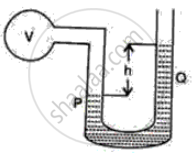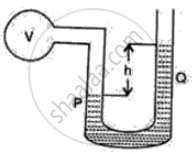Advertisements
Advertisements
प्रश्न
The following figure shows a manometer containing a liquid of density p. The limb P of the manometer is connected to a vessel V and the limb Q is open to atmosphere. The difference in the levels of liquid in the two limbs of the manometer is h as shown in the diagram. The atmospheric pressure is P0.
(i) What is the pressure on the liquid surface in the limb Q?
(ii) What is the pressure on the liquid surface in the limb P?

उत्तर

(i) The pressure on the liquid surface in the limb Q is equal to atmospheric pressure i.e P0.
(ii) According to the manometer principle, the difference in atmospheric pressure in two limbs is equal to the difference in height of liquid in two limbs.
So pressure at P = pressure at Q + h × p × g.
P0= PQ + h ×p × g.
APPEARS IN
संबंधित प्रश्न
Name three applications of Pascal's law.
What is the use of altimeter?
State two applications of Pascal's law.
State the principle on which Brahma press depends.
The density of iron is 7800 kg m-3. What do you mean by this statement? What is density of water at 40C?
Analogy
Pascal’s law: ______:: Surface tensin: ______.
Match the following:
| 1. | Hydraulic press | a. | Archimedes |
| 2. | Cartesian Diver | b. | Floatation |
| 3. | Hydrostatic Balance | c. | Pascal’s law |
| 4. | Hydrometer | d. | Buoyancy |
What are Force multipliers?
A hydraulic press can lift 100 kg when a mass 'm' is placed on the smaller piston. It can lift ______ kg when the diameter of the larger piston is increased by 4 times and that of the smaller piston is decreased by 4 times keeping the same mass 'm' on the smaller piston.
